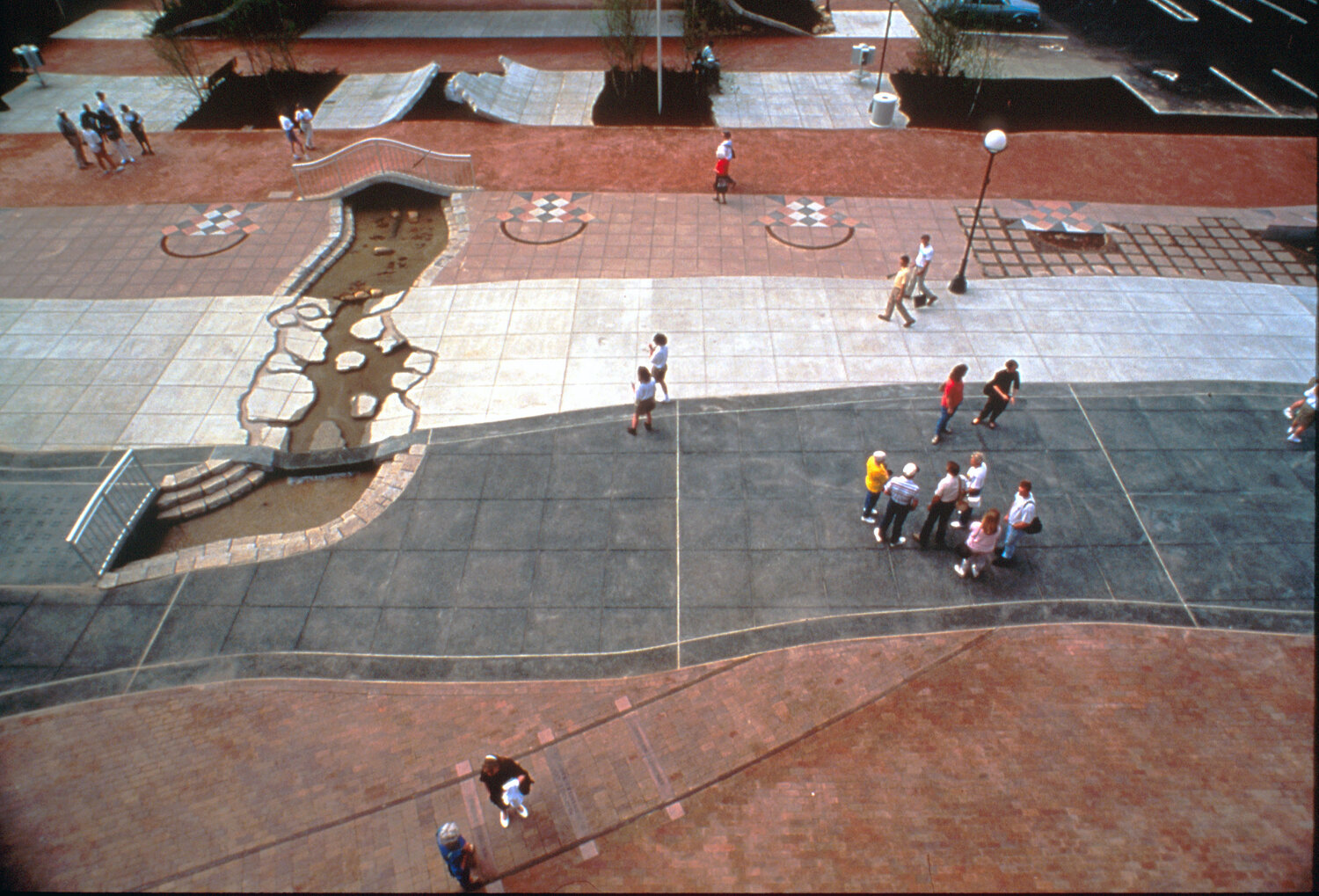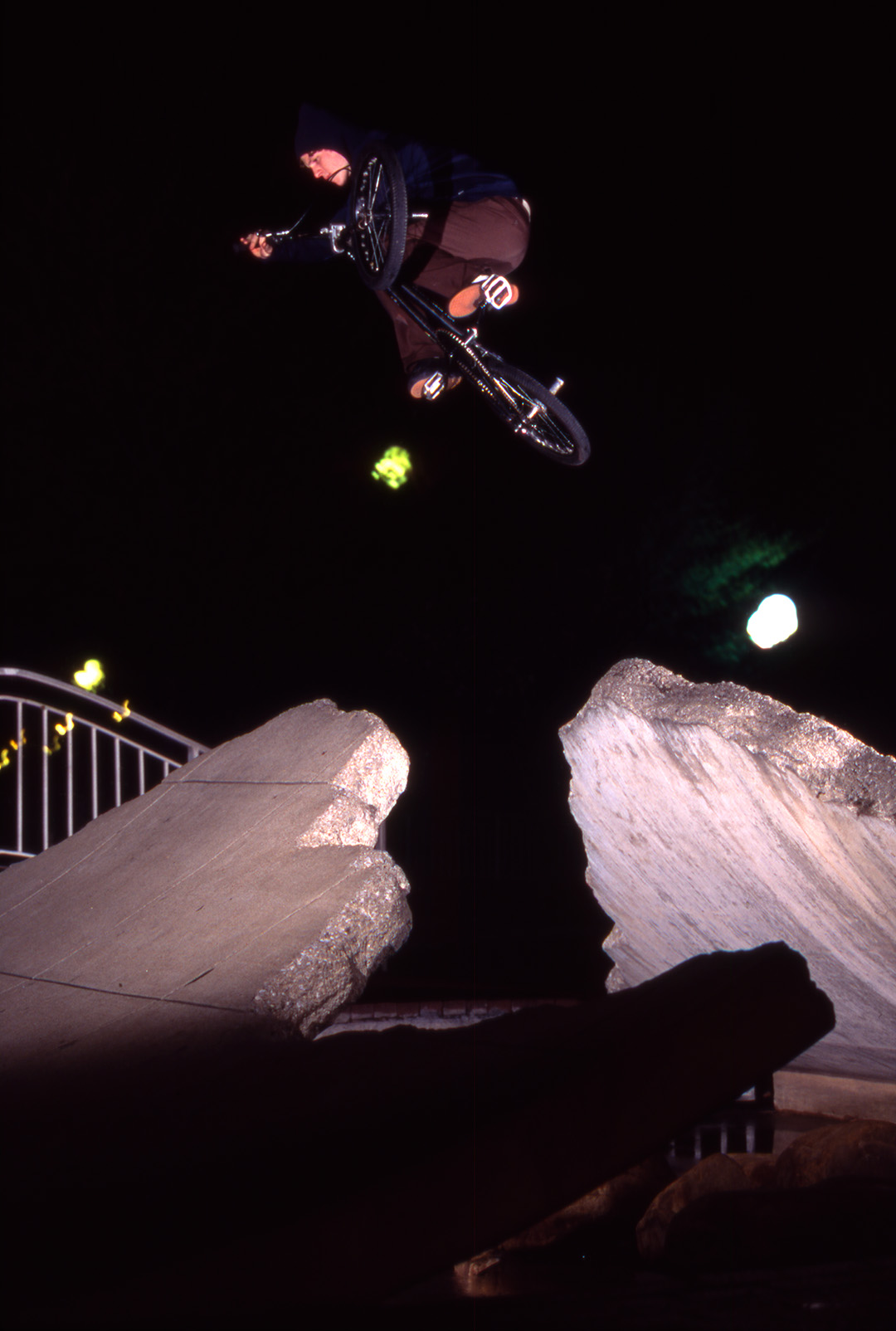Spot Reference:
Ross's Landing, Chattanooga
by Nick Ferreira

photo via SITE/James Wines LLC

Bob Scerbo by Jeff Zielisnki
In Chattanooga, TN lives a structure that might as well be the poster-child of a specific early 2000s transition based street spot. The Chattanooga spine was a video-part staple for those seeking secret spot credibility. Superstars dropped truckdrivers (shout out to Corey Martinez) and almost all of the footage was at night as legend has it the bust factor was/is high. Photographs of the spot made it seem like some weird one-off sculpture but the spine is just one component of Ross’s Landing Park and Plaza and the Tennessee Aquarium.
![]()
Ross’s Landing Park is named after John Ross, the Principal Chief of the Cherokee Nation. Ross founded the original settlement of Chattanooga, Ross’s Landing in 1816. The settlement’s name was changed to Chattanooga after the United States systematically began removing the Cherokee Nation, now known as “The Trail of Tears.” The park’s production, started in 1992, was overseen by EDAW Landscape Architects of Alexandria, VA where they led a team of artists, architects, and engineers. The artists included Jack Mackie and Stanley Townsend, and James Wines of SITE (Sculpture in the Environment). Wines and his firm SITE, a New York based architecture and environmental arts studio founded in 1970, played an instrumental role in the park’s design and completion.
According to SITE, the park and plaza “combined public spaces and gardens are treated as a microcosm of the region, including its urban grid, mountainous terrain and riverbank configuration”. The design of the park uses SITE’s signature style of cheerful dystopia. As if the world is falling apart but it’s not all bad because mother nature is still here underneath us. In fact, Wines, interviewed in the May 1998 issue of Architecture magazine, discusses the destruction of the earth:

Ross’s Landing Park is named after John Ross, the Principal Chief of the Cherokee Nation. Ross founded the original settlement of Chattanooga, Ross’s Landing in 1816. The settlement’s name was changed to Chattanooga after the United States systematically began removing the Cherokee Nation, now known as “The Trail of Tears.” The park’s production, started in 1992, was overseen by EDAW Landscape Architects of Alexandria, VA where they led a team of artists, architects, and engineers. The artists included Jack Mackie and Stanley Townsend, and James Wines of SITE (Sculpture in the Environment). Wines and his firm SITE, a New York based architecture and environmental arts studio founded in 1970, played an instrumental role in the park’s design and completion.
According to SITE, the park and plaza “combined public spaces and gardens are treated as a microcosm of the region, including its urban grid, mountainous terrain and riverbank configuration”. The design of the park uses SITE’s signature style of cheerful dystopia. As if the world is falling apart but it’s not all bad because mother nature is still here underneath us. In fact, Wines, interviewed in the May 1998 issue of Architecture magazine, discusses the destruction of the earth:
“Our attitude is insane: You pave over everything. A river overflows and everything washes away. And you blame the government. You call it a natural disaster! That’s ironic. It’s a totally man-made disaster!
— James Wines

photo via SITE/James Wines LLC
Wines and SITE have been an advocate of green and sustainable design since its inception. But Wines, quick to point out the importance of aesthetics, is uninterested by boring, “green” design. Alternatively, Wines is also critical of star architects and their use of, in his words “anti-ecological materials” in their masterpieces, like Frank Gehry’s use of titanium in his Bilbao Guggenheim design.
Wines and SITE, while working on “high-brow” projects like Highway ‘86 for Vancouver’s Expo ‘86 and the Visitor’s Center for the Fondazione Pietro Rossini Sculpture Park, have also focused on projects for “low-brow” clients like McDonald’s with their “floating” building in the fast-food behemoth’s hometown of Berwyn, IL. Perhaps their best known project was their early work with the showroom and mail order business, Best Products. SITE played with the all too familiar box retail store design using movable facades and faux-crumbling walls. SITE continues to work today incorporating their much needed sculptural sensibilities into design and architecture, while being conscious of their role in affecting the environment. No further transitioned street spots have been created. Yet. ︎
Further Reading:
“Ross’s Landing: a Sense of History.” Landscape Online, Accessed 20 September 2017.
“Site Survey.” Architecture, vol. 87, no. 5, 1998, pp. 77-85
Wines, James, and Herbert Muschamp. Site. New York: Rizzoli, 1989. Print.
Womersley, Steve. Site: Identity in Density. Mulgrave, Victoria: Images Publishing, 2005. Print.
Wines and SITE, while working on “high-brow” projects like Highway ‘86 for Vancouver’s Expo ‘86 and the Visitor’s Center for the Fondazione Pietro Rossini Sculpture Park, have also focused on projects for “low-brow” clients like McDonald’s with their “floating” building in the fast-food behemoth’s hometown of Berwyn, IL. Perhaps their best known project was their early work with the showroom and mail order business, Best Products. SITE played with the all too familiar box retail store design using movable facades and faux-crumbling walls. SITE continues to work today incorporating their much needed sculptural sensibilities into design and architecture, while being conscious of their role in affecting the environment. No further transitioned street spots have been created. Yet. ︎
Further Reading:
“Ross’s Landing: a Sense of History.” Landscape Online, Accessed 20 September 2017.
“Site Survey.” Architecture, vol. 87, no. 5, 1998, pp. 77-85
Wines, James, and Herbert Muschamp. Site. New York: Rizzoli, 1989. Print.
Womersley, Steve. Site: Identity in Density. Mulgrave, Victoria: Images Publishing, 2005. Print.
